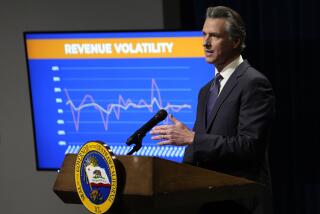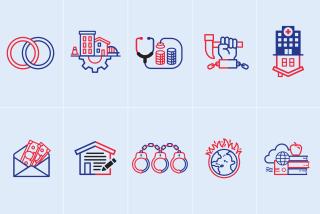Health Insurance, Deficit Woes Tackled by Props. 166 and 167
- Share via
Come Nov. 3, California voters will get a whack at a couple of the state’s most pressing problems--health care and the state budget gap--in two ballot initiatives of profound importance to business.
Proposition 166, put forward by the California Medical Assn., would require firms to provide health insurance for employees working at least 70 hours a month. Proposition 167 would raise taxes on business and the rich while cutting sales taxes.
The health care proposal can be readily dismissed. Although 6 million uninsured Californians desperately need coverage, Prop. 166 wouldn’t cover many part-timers or the unemployed, wouldn’t halt the upward spiral of costs and would burden small business.
“If voters approve the CMA plan, they’ve bought a hoax,” says Lois Salisbury, chairwoman of the nonprofit Health Access Foundation of California, a consumer coalition advocating universal coverage.
Prop. 167 is a different story. It is a complex and thoughtful plan to adjust the tax burden and raise a little money for the state and for hard-pressed local governments.
The timing sounds dubious. California is stuck, after all, in its worst recession since the Great Depression, and higher levies on business will make neighboring states with lower taxes look even more attractive.
On the other hand, opponents of Prop. 167 are being disingenuous if they don’t propose some other way for state and local governments to raise money or cut spending, because California’s $40.8-billion general-fund budget isn’t really balanced. The bipartisan Commission on State Finance is already predicting a $2-billion shortfall by June 30, when the fiscal year ends.
Moreover, Prop. 167 wouldn’t raise overall taxes much, and some of the opposing rhetoric--that it will destroy small business--is overblown. Prop. 167 would cut some taxes, and those it would raise are largely federally deductible.
Developed by Lenny Goldberg, executive director of the nonprofit California Tax Reform Assn., and funded by various unions, Prop. 167 would reduce the sales tax by a quarter of a point, restore the exemption for candy, snack food, bottled water, newspapers and periodicals and give a tax credit to all renters. These moves would cut 1993-94 taxes by $1.5 billion.
Prop. 167 would pay for this by:
* Hiking California’s corporate income tax to 10.3% from 9.3%.
* Limiting the special tax status known as Subchapter S, which helps small corporations lower their taxes, to those with annual revenue below $10 million.
* Creating a 12% marginal tax bracket for individuals earning $250,000 or couples earning $500,000 annually. Temporary rates of 10% and 11% would become permanent.
* Changing the way multinational corporations calculate their California taxable income.
* Levying a 3% oil severance tax on producers of more than 30,000 barrels a month.
* Subjecting banks to local business taxes (they now make “in lieu” payments that are usually lower) and allowing them to deduct only actual loan losses rather than loan-loss reserves.
* Barring companies with more than 1,000 workers from taking a state tax deduction for the portion of any executive’s pay exceeding 25 times that of the firm’s average worker.
The biggest hit for business--$1 billion to $2 billion beginning in 1993-94--would come from a requirement that corporate property be reassessed when majority ownership changes hands, r ather than just when a single owner gets more than 50%.
Prop. 167 would mean a net revenue increase of just $245 million in the current fiscal year, when California’s economy is liable to remain in the doldrums. But in fiscal 1993-94, when the economy ought to be improving, the initiative should be generating revenue of between $1.1 billion and $2.2 billion. Remember: A substantial portion of that would be offset by deductions from federal income taxes.
In an ideal world, Prop. 167 would be a mistake. A ballot initiative is no way to adopt complex legislation, after all. And California would be better off raising money with a higher gasoline tax--ours is among the lowest--and some kind of transfer tax on real estate profits.
But we don’t live in an ideal world. We live in California, where people value driving over breathing and the state Constitution says gasoline levies can only be used for transportation.
Isn’t this already a high tax state? Well, Steven Gold, director of the Center for the Study of the States in Albany, N.Y., figures that California’s state and local tax burden was $11.41 per $100 of personal income in 1990--about the national average. In 1978, by contrast, California’s was America’s fourth highest, at $14.62.
What’s more, bank and corporate taxes have markedly declined as a proportion of state spending. In fiscal 1991, they were 11.9% of the basic state budget, down from 15.3% a decade earlier.
Won’t businesses flee? The governor’s Office of Planning and Research says Prop. 167 would cost 105,300 jobs (in an economy of 14 million). But fleeing businesses usually cite the high costs of housing, skilled labor, workers’ compensation and red tape. Taxes aren’t the major factor.
Nobody likes taxes. Gold and other thoughtful people across the political spectrum are urging more market-based pricing and taxing to encourage efficiency and deter socially expensive activity. Tax parking to reduce driving, for example, and raise money for transit. Tax legal fees. Bring competition to bear on education.
But until such reforms, this state is in a bind. The demand for government services in the 1990s--in health care, schools, law enforcement and infrastructure--is likely to grow, and a crumbling, undereducated California can’t offer much of a business climate.
The money’s got to come from somewhere. Prop. 167 is better than most feasible ideas, and more feasible than most better ideas. We could do much worse.
More to Read
Get the L.A. Times Politics newsletter
Deeply reported insights into legislation, politics and policy from Sacramento, Washington and beyond. In your inbox three times per week.
You may occasionally receive promotional content from the Los Angeles Times.









